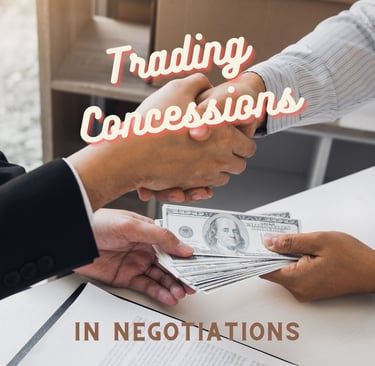The Art of Trading Concessions in Negotiation
Learn how to stop giving and start trading concessions in negotiation. Master the art of trading smart, strategic concessions that protect value and build respect.
TRADING CONCESSIONSNEGOTIATION STRATEGIESPRINCIPLED NEGOTIATIONART OF NEGOTIATIONNEGOTIATION SKILLSWIN-WIN NEGOTIATIONNEGOTIATION TACTICSCHRIS VOSSGETTING TO YESWILLIAM URYNEVER SPLIT THE DIFFERENCEPERSUASIVE NEGOTIATION
Ashish Mendiratta
11/6/20256 min read


The Costliest Lesson I Learned from a Negotiation
The quiet in the boardroom that day felt heavier than it should have. We were negotiating our annual IT services contract — the one that underpinned infrastructure, managed services, and a great deal of our uptime. The supplier set the opening: ₹60 crore. On the other side of the table, my team and I had a tight budget number: ₹50 crore.
That gap — ₹10 crore — was significant. It mattered to our P&L. It mattered to our programs. It mattered to the CFO. And the supplier knew it.
We talked, we argued, we explained costs and risk layers. We each placed our anchors. I opened at ₹50 crore deliberately; it was firm but not insulting. The supplier anchored the conversation at ₹60 crore to protect headroom. It felt like a classic negotiation dance.
But as the hours wore on, I started to feel the fatigue we all know too well. The supplier circled again, pushed, and I began to make concessions to show good faith. We moved: to ₹52 Cr, then ₹54 Cr, then finally ₹56 Cr — each time stepping up ₹2 crore.
Handshake. The room sighed. Deal done.
On paper it looked like a workable compromise. But later, as I walked back to my office, something nagged at me. Each ₹2 crore step had seemed innocuous. Yet the final number — ₹56 crore — stung. Why had I left ₹6 crore on the table? Why had I given away so much margin in predictable, round moves?
That night a senior peer texted: “Three classic mistakes today. Can you spot them?” I couldn’t at first. Those mistakes are subtle — and therefore dangerous. They leak value slowly, almost imperceptibly, until a seemingly fair deal actually costs you dearly. Over the next few years, I turned those painful lessons into habits. I learned to never give without getting, to pace concessions in diminishing increments, and to use precise numbers that scream “calculation, not guess.”
Why Concessions Matter (and Why We Give Too Easily)
Most negotiators believe concessions are a way to create goodwill or speed up a stalemate. So we give — a little at first — to show we are reasonable. But unstructured giving is rarely rewarded. Instead, it becomes expected.
There are three driver emotions behind bad concessions:
Urgency: When deadlines loom, we panic and make bigger moves to avoid an operational risk.
Fatigue: Negotiations exhaust patience; tired people trade too much.
Approval bias: We want to be cooperative or “liked,” and so we trade away leverage.
The problem is not generosity; it’s unconditional generosity. Any concession that isn’t explicitly tied to something the other side values back is a unilateral gift. Over a large contract, these gifts add up.
Mistake 1 — Conceding Without Trading
In my IT contract, after the supplier pushed, I moved from 50 → 52 → 54 → 56 without demanding anything specific in return. That’s the key error: conceding while hoping for goodwill instead of extracting a quid pro quo.
An alternative? A conditional concession. For example:
“We can move to ₹52 Cr — if you include two critical SLAs for uptime at no extra charge.”
“We’ll consider ₹54 Cr — provided you commit to a 2-year rate lock and a fixed resource allocation for our migration window.”
These “if” clauses do two things: they make what you give feel earned, and they build a record of reciprocal value. William Ury’s core advice around principled negotiation is relevant here: separate people from the problem, focus on interests, and invent options for mutual gain. A concession that’s traded aligns interests; a concession that’s free leaves the other side feeling they’ve won by pressure.
Mistake 2 — Moving in Big, Equal Steps (Predictability Kills Leverage)
The most costly error in that contract was structural: my pattern of movement. By increasing my offer by ₹2 Cr each round (50 → 52 → 54 → 56), I signaled a rhythm. Predictability is power for your counterpart.
Consider the supplier’s perspective: if they expect you to move in uniform steps, they can map your endpoint in two rounds. If I’d instead moved in diminishing increments — e.g., 50 → 52 → 53 → 53.5 → 53.75 — I would have:
Signaled that each concession costs me more (because steps are getting smaller).
Created uncertainty about how much more I would move.
Communicated that I was approaching a limit.
Why does reducing the quantum matter? Psychologically, it sends the message that the juice is running out. The other party stops pushing as hard because they perceive less room to exploit. That perception is often more valuable than the exact numbers: it protects margin.
Large, equal jumps (like ₹2 Cr each time) tell a supplier: “I can afford to move in chunks.” Smaller, tapering moves tell them: “I’ve thought about my thresholds; every step is deliberate.” This is critical in high-stakes negotiations where a few crores are material.
Mistake 3 — Using Rounded Numbers
Using round numbers — 50, 52, 54, 56 — makes you sound casual. It signals rough estimates, not careful analysis.
Chris Voss and many negotiation practitioners emphasize the power of specificity. A number like ₹53.75 Cr reads as the result of analysis, not guesswork. It implies you’ve arrived at a threshold via cost models and trade-offs.
In practice, if you move in precise, non-rounded increments, you:
Convey that you have a well-calculated walk-away point.
Reduce the supplier’s temptation to press because the figure seems deliberate.
Add friction to the supplier’s psychology: they now have to justify chasing cents, not rounded crores.
So instead of announcing “we’ll go to ₹54 Cr,” try “we can go to ₹53.4 Cr if you extend the rate lock.” The decimal creates pause, and pauses are precious currency in negotiation.
How to Trade Concessions — Practical Tactics That Work
Here’s a tactical playbook — practical actions I now use to trade (not give):
1) Always attach an “If” to every concession
Every move must have a return. Even if the return is procedural (a bullet in the SOW, a signing bonus, a milestone payment), make it explicit.
Example: “We can accept the rate at ₹52 Cr — if you include one additional FTE for migration support during Q2.”
2) Use diminishing increments
Start with a modest first concession to show movement, then reduce each subsequent step:
50 → 52 → 53 → 53.5 → 53.75 … This communicates scarcity and a clear limit.
3) Be specific with numbers
Use decimals and odd figures when you can. They signal calculation. e.g., ₹53.6 Cr reads differently than ₹54 Cr.
4) Pre-define your tradeables
Before you walk into the room, list items you can trade (SLA level, maintenance windows, support FTEs, payment terms, early payment discounts, pilot scope). Assign a notional value to each so you can quantify trades during the conversation.
5) Document each trade
When you accept a concession, summarize the deal in writing: “We agree to ₹52 Cr in exchange for committed resource X, signed into the SOW.” That stops “friendly” backtracking.
6) Use silence and the “let me check” pause
Slow the rhythm. If the vendor pushes, don’t respond immediately. Take time; consult; make them wait. It signals deliberation.
Psychology — Why This Works
Three psychological forces make the above tactics effective:
Reciprocity: When you request a trade, the other side feels obliged to return the value. Free gifts don’t trigger the same response.
Perception of Scarcity: Diminishing moves signal limited room; scarcity reduces aggressive pushing.
Credibility via Specificity: Precise figures and defined trades suggest the numbers came from modeling, not emotion.
These are not tricks; they are behavioral levers that align negotiation outcomes with rational, mutually beneficial solutions.
The Final Checklist — Before You Concede
Use this checklist every time you think of moving:
Is this concession conditional? (If not, stop.)
Have I reduced the size of my concession from the previous move?
Is the number precise and defensible?
Have I quantified what I’m asking for in return?
Have I documented the traded concessions?
Do I know my BATNA and walk-away number?
Have I used a “let me check” pause to slow the rhythm?
If you can answer yes to most of these, you’re trading. If not, you’re giving.
Closing: From “Okay” to “If” — The Power of Intentional Movement
That annual IT contract taught me a lesson I wish I’d learned earlier: concessions are not mileposts of goodwill. They are instruments of leverage. Use them casually and you will bleed margin. Use them deliberately and you’ll create mutual value.
So next time you’re at the table, pause before you move. Ask:
Am I trading?
Is my next step smaller than my last?
Does this number look like calculation or guesswork?
If the answer is yes to all three, you are trading like a professional. If not, you’re likely about to sign away value in neat, predictable chunks.
Negotiation is math — but it’s also language. Speak the language of trades, not giveaways. You’ll close fewer “quick” deals, but you’ll win far more meaningful ones.
Because in negotiation, the best “yes” you can give is the one that was earned — and the best “no” is the one that leads to a better trade.
Subscribe
Contact:
contact@advanchainge.com
+91-9873829286
deepak.nande@advanchainge.com
+91-9820291969



